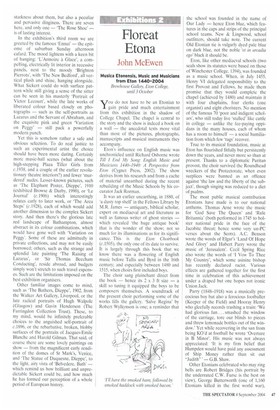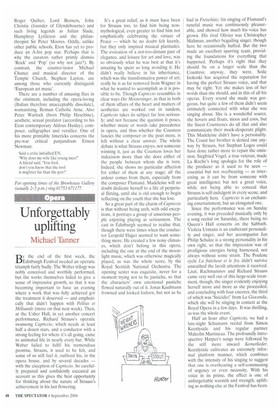Floreat Etona
John McEwen
Musica Etonensis, Music and Musicians from Eton 1440-2004 Brewhouse Gallo); Eton College, until 3 October
you do not have to be an Etonian to gain pride and much entertainment from this exhibition in the shadow of College Chapel. The chapel is central to the story and the show is indeed a book on a wall — the anecdotal texts more vital than most of the pictures, photographs, manuscripts and musical instruments they accompany.
Eton's influence on English music was unchronicled until Richard Osborne wrote Till I End My Song: English Music and Musicians 1440-1940: A Perspective from Eton (Cygnet Press, 2002). The show derives from his research and from a cache of material unearthed during the recent rebuilding of the Music Schools by his cocurator Jack Rozman.
It was an earlier unearthing, in 1880, of 'a dusty top shelf in the Fellows Library by M.R. James — antiquary, biblical scholar, expert on mediaeval art and literature as well as famous writer of ghost stories — which revealed `the huge antique book' that is the wonder of the show; not so much for its illuminations as for its significance. This is the Eton Choirbook (c.1505). the only one of its date to survive. It is largely through this book that we know there was a flowering of English music before Tallis and Byrd in the 16th century; and especially between 1480 and 1515, when choirs first included boys.
The choir sang plainchant direct from the book — hence its 2 x 3 ft size — a skill so taxing it equipped the boys to be composers themselves. A soundtrack of the present choir performing some of the works fills the gallery. 'Salve Regina' by Robert Wylkynson is one; a reminder that the school was founded in the name of Our Lady — hence Eton blue, which features in the caps and strips of the principal school teams. New & Lingwood, school outfitters, should take note. The current Old Etonian tie is vulgarly dyed pale blue on dark blue, not the noble 'et in arcadia ego' black it should be.
Eton, like other mediaeval schools (two seals show its statutes were based on those of Winchester College, 1394), was founded as a music school. When, in July 1455, Henry VI delegated responsibility to the first Provost and Fellows, he made them promise that they would complete the chapel (achieved by 1480) and maintain it with four chaplains, four clerks (one organist) and eight choristers. No mention of the famous 70 'poor and indigent scholars', who still today live 'stalled' like cattle in college — unlike the fee-paying oppidans in the many houses, each of whom has a room to himself — a social humiliation from which few 'tugs' recover.
True to its musical foundation, music at Eton has flourished fitfully but persistently down the years, and never more so than at present. Thanks to a diplomatic Puritan provost, the choir survived the Roundhead wreckers of the Protectorate, when even surplices were banned as an offence against 'the law and the liberty of the subject', though singing was reduced to a diet of psalms.
The most public musical contribution Etonians have made is to our national anthems. Thomas Arne wrote the music for 'God Save The Queen' and 'Rule Britannia' (both performed in 1745 to bolster national pride in the face of the Jacobite threat; hence some very un-PC verses about the Scots). A.C. Benson wrote the words of Elgar's 'Land Of Hope And Glory' and Hubert Parry wrote the music of 'Jerusalem'. Cecil Spring Rice also wrote the words of 'I Vow To Thee My Country', which some asinine bishop has recently declared racist. Various effects are gathered together for the first time in celebration of this achievement under a draped but one hopes not ironic Union Jack.
Parry (1848-1918) was a musically precocious boy but also a ferocious footballer (Keeper of the Field) and Hooray Henry who gleefully records trashing a train: 'We had glorious fun ... smashed the window of the carriage, tore our blinds to pieces and threw lemonade bottles out of the window.' Yet while recovering in the san from being KO'd at football he wrote 'Overture in B Minor'. His music was not always appreciated: 'It is my firm belief that Hampden would have paid any assessment of Ship Money rather than sit out "Judith" ' — G.B. Shaw.
Other Etonians celebrated who may ring bells are Robert Bridges (his portrait by the underrated C.W. Furse is the best on view), George Butterworth (one of 1,160 Etonians killed in the first world war), Roger Quilter, Lord Berners, John Christie (founder of Glyndebourne) and such living legends as Julian Slade, Humphrey Lyttleton and the philanthropist Sir Peter Moores. Oddly, unlike other public schools, Eton has yet to produce an A-list pop star. Perhaps that is why the curators rather primly dismiss 'Rock' and 'Pop' (so why not jazz?). By contrast, the counter-tenor Michael Chance and musical director of the Temple Church, Stephen Layton, are among those who currently distinguish 'European art music'.
There are a number of amusing flies in the ointment, including the opera-loving (Italian therefore unacceptably dissolute), womanising, Roman Catholic Arne. Also Peter Warlock (born Philip Hese!tine), aesthete, sexual predator (according to his Eton contemporary Aldous Huxley), composer, calligrapher and versifier. One of his more printable limericks concerns the pre-war critical panjandrum Ernest Newman:
Said a critic initialled EN, 'Why does my wife like young men?'
A friend said. 'You fool, don't you know that the tool is mightier far than the pen?'
For opening times of the Brewhouse Gallery (usually 2-5 p.m.) ring 01753 671177.



































































 Previous page
Previous page